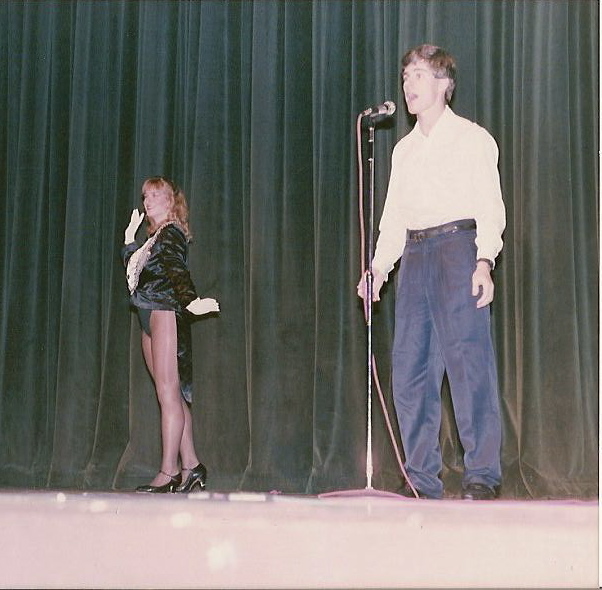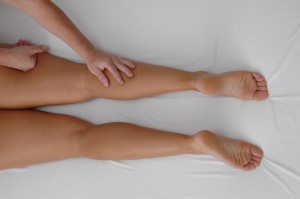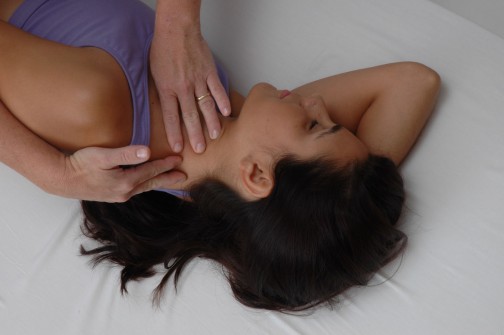
Carole LaRochelle third from the right.
Here is the final installment of the 3 part series about how I became a Certified Rolfer.™ In Part 3 I discover my love for dance, receive my first taste of hands-on manual therapy for a dance injury, and discover my life’s work Rolfing® SI.
Read Part 1 and Part 2 of this series
— After graduating from university I tried to force myself into a career as an accountant.
I enjoyed the intellectual challenge of working in the business world, but was unhappy sitting at a desk all day long. Upon taking my first full-time job my gloom about my profession started to grow.
Each day at work felt like a slow soul death and most of my nights were spent being sick to my stomach. At some point in the future I knew my inner spark would be completely snuffed out. I was living a double life.
During the day I did my best to be a business professional, but after work, most every night, I headed to ballet class. I loved ballet.
I had started taking formal dance lessons at the age of 15, first in jazz and then moved on to tap dancing. I noticed some dancers had much better technique than others. I found out they had studied ballet.
Given my leg issue history and not fond memories of ballet from pre-school age I had steered clear of those classes.
From tap to ballet
However, the tap dance studio was in the same building as the ballet school. I would watch the students c ome and go, and hear the classical music drifting out from behind closed doors.
ome and go, and hear the classical music drifting out from behind closed doors.
Doesn’t every little girl dream of becoming a ballerina?
I decided to take a beginning class, just to improve my technique. It was hard, and I wasn’t built for it, but I loved it. I gave up tap dancing just to focus on ballet. I had the good fortune to have a teacher, Antonio Mendes, who noticed how committed and hard working I was, and he encouraged me.
I continued dancing while in college, both at the ballet school and at the university. I knew I wasn’t capable of having a professional career as a dancer and would have to give it up at some point, but I just couldn’t stop. Dancing felt wonderful, and freeing.
I felt beautiful when I moved.
An injury slows me down. . .briefly
At around the same time I graduated from university I also managed to injure myself dancing. I damaged my left hamstring to the point I couldn’t balance on that leg and when walking would have to pull it along behind me.
I sought out physical therapy and was eventually referred to Dr. Garrick at Saint Francis Memorial Hospital’s Center for Sports Medicine. I’d never been to a clinic like this.
It was everything under one roof, orthopedics, podiatry, physical medicine, sports medicine, physical therapy and unique to Saint Francis, dance medicine. I worked with the Pilates trainers there, and ran into one of my dance teachers from Sonoma State University, Mercy Sidbury. She had been the first person to introduce me to Pilates principles back in the late 80s.
A chance to try a new therapy
 One particular dance medicine specialist inquired if I’d had any manipulation done on my leg. My response, “No, they do that?” Up to that point all the treatment I had received focused on exercise and stretching. No therapist had actually touched me.
One particular dance medicine specialist inquired if I’d had any manipulation done on my leg. My response, “No, they do that?” Up to that point all the treatment I had received focused on exercise and stretching. No therapist had actually touched me.
The specialist referred me to a chiropractor who referred me to a massage therapist, and thus I received my first taste of hands-on manual therapy. It was transformative. My intelligent bodymind knew it was exactly what I needed: hands-on work to break up the scar tissue in my hamstring.
But, what was I going to do about my career? I felt strongly I needed to do something more fundamental and grounded then work in the abstract world of numbers. I liked the clinic at Saint Francis and began to ponder how I could get the skills to work at such a place.
Also, for me, there was something magic and powerful about touch. I decided to quit my full-time job and enroll in massage school.
While in massage school, I continued dancing and exploring movement. I took Feldenkrais classes, modern dance classes, yoga. I kept learning more and more about body structure and how bodies work in motion. The woman who ran the massage school brought in the local Certified Rolfer™ to speak with us about his work.
My life changing introduction to Rolfing SI
From somewhere deep in the recesses of my mind I remembered Rolfing SI. Rolfing SI changes structure. . . I have structural issues. . . being able to change structure is a good thing.
I volunteered to be the model for the Rolfing demo. The first thing the Rolfer™ did was have me stand so he could look at my structure. He described to me what he saw, and what he described made perfect sense to me. I felt it in my body standing there, and had felt it previously when at the barre in ballet.
my structure. He described to me what he saw, and what he described made perfect sense to me. I felt it in my body standing there, and had felt it previously when at the barre in ballet.
He told me he could help me change my structure, and that the changes would last a long time. (Something that resonated for me. I’d been getting a massage a week on my hamstring and felt strongly I needed something that would have a longer lasting impact.)
I eagerly laid down on the table and he started to touch me, touch like I’d never felt before. His touch had an intelligence to it, a listening quality. It was like he was having a conversation with my flesh.
His touch had no quality of the rather mindless pushing, pressing or kneading that can often be likened to one’s body being a lump of clay that the other person is trying to mold or soften into some shape.
No, he was asking my body to open here, let go there, and listening for the response from my system. This conversation was highly conscious non-verbal communication between our two dynamic, biological living systems.
I was smitten, not by him, but by the work.
It was on that day in 1992 I knew I had found my calling. I would combine my curiosity and interest in body structure with my love for touch and train to become a Certified Rolfer.™
Read Part 1 and Part 2 of this 3 part series.



Dear Carole, I read parts 1 and 2. Fascinating. Part 3 is not to be found. Bob
Your reading was the motivation for me to fix the article. I have now posted the entire piece.